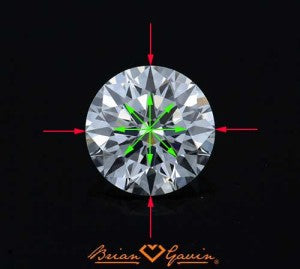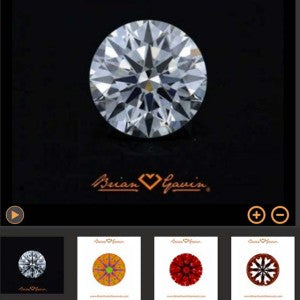
How do you calculate diamond measurements?
“Please explain how to calculate diamond measurements. How exactly do you determine the proportions of a diamond? I realize that the measurements of a diamond are provided on the diamond grading report, but I’m curious about how those measurements are determined. Is there a formula that a layperson can follow to determine the proportions of a diamond? Are the diamonds measured by hand, or are the proportions measured by some sort of machine? If both methods are used, what is the reliability of the process? And how can I ensure that the diamond I purchase is going to exhibit the best light return?”
Calculating diamond proportions, then and now:
Calculating the proportions of a round brilliant cut diamond used to be a painstaking and lengthy endeavor. One of the tools that was used to increase speed and accuracy was the GIA Table Gauge pictured above. It was considered to be the most accurate way to measure the table diameter of a diamond. It probably still is the most accurate way to determine the table size of a diamond, if you’re going to try and do it by hand. But we really don’t do that any more…
But for the sake of history and being able to appreciate our gemological roots, and the progress that we’ve made due to major advances in technology, here’s a quick tutorial on how to use a GIA Table Gauge:
As you can see, a GIA Table Gauge is a small, translucent ruler made of plastic. The units of measurement shown on the ruler are in tenths of a millimeter (0.1 mm). You’re going to need a diamond grading scope to do this accurately. I’ve seen people try to do it with a handheld loupe, but things get pretty shaky.
Measuring diameter and table size:
 The first thing you’re going to do is determine the outside diameter of the diamond using a micrometer. Measure across the diamond from north to south, and east to west, as indicated by the red arrows. For the purpose of this tutorial, the diamond measures 6.48 x 6.53 millimeters in diameter and has a depth of 4.00 millimeters. The first thing we need to do is determine the average outside diameter. This is done by adding the two measurements together, and then dividing them by two: 6.48 + 6.53 = 13.01 / 2 = 6.505 mm. The average outside diameter of this diamond is 6.505 millimeters.
The first thing you’re going to do is determine the outside diameter of the diamond using a micrometer. Measure across the diamond from north to south, and east to west, as indicated by the red arrows. For the purpose of this tutorial, the diamond measures 6.48 x 6.53 millimeters in diameter and has a depth of 4.00 millimeters. The first thing we need to do is determine the average outside diameter. This is done by adding the two measurements together, and then dividing them by two: 6.48 + 6.53 = 13.01 / 2 = 6.505 mm. The average outside diameter of this diamond is 6.505 millimeters.
The next step is to determine the table diameter of the diamond. You will use the GIA Table Gauge to do this. Holding the diamond securely with a diamond gripper, you would hold the gauge across the table facet of the diamond, and measure across the table facet of the diamond as indicated by the green arrows. You’ll be measuring from the junction point that is located between the pairs of star facets, which are the small triangular facets that border the table facet. Add the six table measurements together, divide by six, and you’ll have the average table diameter in millimeters. For the sake of argument, let’s say that it’s 3.58 mm.
Now divide the average table facet measurement by the average outside diameter and multiply that sum by 100 to get the table percentage: 3.58 / 6.505 = 0.5503458 × 100 = 55.03% which will be rounded off to 55% table diameter. Needless to say, manually measuring a diamond and calculating the proportions is a time consuming process. It also isn’t all that accurate.
Computerized diamond proportions analysis:
Thankfully advances in technology provided the diamond industry with state-of-the-art, computerized, equipment which measures diamonds and calculates the proportions in less than a minute. Not only is using computerized proportions analysis to calculate diamond proportions faster than doing it manually, it is also much more accurate. This is the technology now used by all major gemological laboratories, and Brian Gavin, to measure diamonds and calculate diamond proportions.
 There really is no need to manually calculate diamond measurements, nor try to estimate crown and pavilion angle by “eye-balling the stone” as they used to do… Can you imagine? Just set the diamond on the platform of the machine, close the lid, push the button, wait a few seconds, and wah-la, the proportions of the diamond are provided.
There really is no need to manually calculate diamond measurements, nor try to estimate crown and pavilion angle by “eye-balling the stone” as they used to do… Can you imagine? Just set the diamond on the platform of the machine, close the lid, push the button, wait a few seconds, and wah-la, the proportions of the diamond are provided.
Needless to say, not all diamonds are created equal. The vast majority of diamonds are cut for profit, not performance. We do things differently at Brian Gavin. Every Brian Gavin Signature round diamond is cut to deliver the highest volume of light return and light performance (sparkle factor). Because we understand that the proportions of a diamond are only once piece of the light performance puzzle, we also focus on optical precision. This ensure the highest volume of light return and sparkle factor, it can only be judged using the multi-colored reflector scope images pictured to the left. Everything you need to make an informed decision, is provided by BGD.
Related: What is the formula for total depth of a diamond if you know the diameter?
















